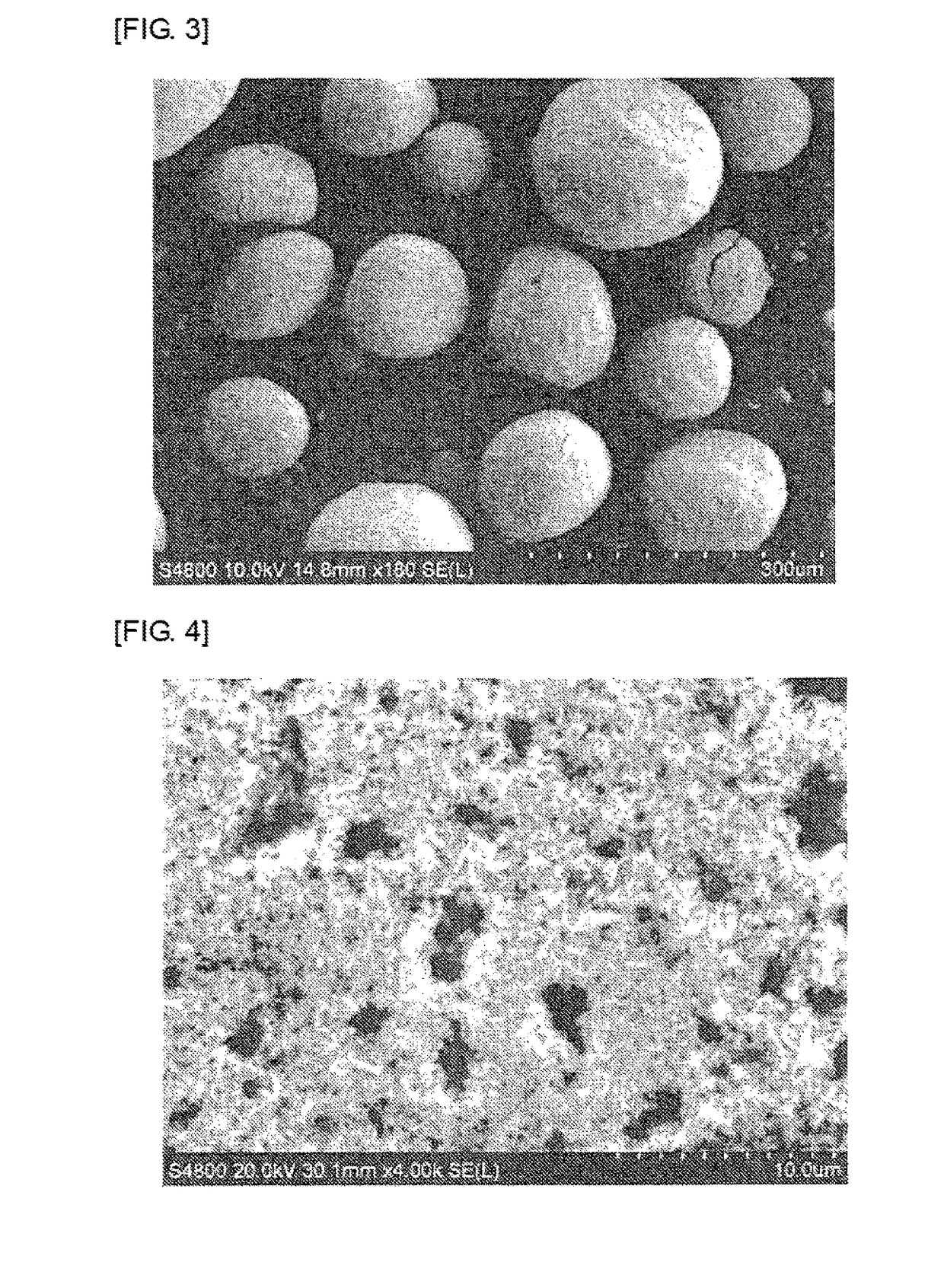Porous titanate compound particles and method for producing same
a technology of porous titanate and compound particles, which is applied in the direction of alkali titanates, other chemical processes, friction linings, etc., can solve the problems of fractional properties not being obtained and friction material resistance decreasing, and achieve excellent fade resistance
- Summary
- Abstract
- Description
- Claims
- Application Information
AI Technical Summary
Benefits of technology
Problems solved by technology
Method used
Image
Examples
example 1
[0049]Titanium oxide and potassium carbonate weighed to give Ti:K=3:1 (molar ratio) were mixed for 10 minutes while being ground with a vibration mill. The resultant ground mixture was dry-granulated with a high-speed mixer and then fired at 850° C. for four hours in an electric furnace, thus obtaining powder.
[0050]The resultant powder was confirmed to be single-phase K2Ti6O13 using an X-ray diffraction measurement device (Ultima IV manufactured by Rigaku Corporation). The average particle diameter was 169 μm, which was derived from a laser diffraction particle size distribution measurement device (SALD-2100 manufactured by Shimadzu Corporation).
[0051]The shape of the resultant powder was observed using a field-emission scanning electron microscope (SEM) (S-4800 manufactured by Hitachi High-Technologies Corporation). FIG. 1 shows a SEM photograph of complete images of particles and FIG. 2 shows a SEM photograph of the infernal structure of a particle. It can be seen from FIGS. 1 and...
example 2
[0054]Titanium oxide and sodium carbonate weighed to give Ti:Na=3:1 (molar ratio) were mixed for 10 minutes while being ground with a vibration mill. The resultant ground mixture was dry-granulated with a high-speed mixer and then fired at 850° C. for four hours in an electric furnace, thus obtaining powder.
[0055]The evaluation of the resultant powder was made in the same manner as in Example 1. As a result, it was confirmed that the powder was single-phase Na2Ti6O13 and spherical particles having an average particle diameter of 56 μm, a cumulative pore volume of 24.0% within a pore diameter range of 0.01 to 1.0 μm, and a maximum value of the pore size distribution of 0.34 μm.
[0056]FIG. 3 shows a SEM photograph of complete images of particles and FIG. 4 shows a SEM photograph of the internal structure of a particle.
[0057]Furthermore, the resultant powder was measured in terms of BET specific surface area, resulting in a BET specific surface area of 4.4 m2 / g.
Example 3
[0058]The titana...
example 3
[0077]Source materials were blended at each compounding ratio according to Table 1 and mixed with a Lodige mixer and the obtained mixture was preliminarily formed (at 25 MPa), thermoformed (at 150° C. and 20 MPa), and further subjected to a thermal treatment at 220° C. to produce a disc brake pad.
[0078]
[0079]A friction test was done using a general-purpose, full-sized dynamometer tester in conformity with JASO C-406. The porosity of the friction material was measured by oil immersion in conformity with JIS D4418. The results are shown in Table 1.
TABLE 1Comp.Ex. 3Ex. 4Ex. 5Ex. 6Ex. 7Ex. 8Ex. 9Ex. 10Ex. 11Ex. 7BlendEx. 1 (porous K2Ti2O13)152010101010[% by mass]Ex. 2 (porous Na4Ti2O13)1520Ex. 3 (porous K2Ti2O13, surface treatment)20Comp. Ex. 1 (hollow K2Ti2O13)15Comp. Ex. 2(pris-moidal K2Ti2O13)Comp. Ex. 3 (platy K2Ti2O13)10Comp. Ex. 4 (platy K Mg Ti O )10Comp. Ex. 5 (platy K Mg Ti O )10Comp. Ex. 6 (amcebol3 K2Mg0.5Ti O )10Phanetic resin55101010101010105Barium sulfate303020202020202020...
PUM
| Property | Measurement | Unit |
|---|---|---|
| Fraction | aaaaa | aaaaa |
| Pore size | aaaaa | aaaaa |
| Length | aaaaa | aaaaa |
Abstract
Description
Claims
Application Information
 Login to View More
Login to View More - R&D
- Intellectual Property
- Life Sciences
- Materials
- Tech Scout
- Unparalleled Data Quality
- Higher Quality Content
- 60% Fewer Hallucinations
Browse by: Latest US Patents, China's latest patents, Technical Efficacy Thesaurus, Application Domain, Technology Topic, Popular Technical Reports.
© 2025 PatSnap. All rights reserved.Legal|Privacy policy|Modern Slavery Act Transparency Statement|Sitemap|About US| Contact US: help@patsnap.com



